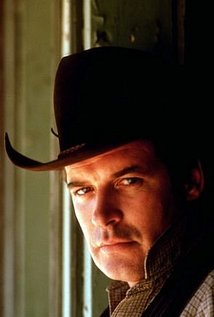
Peter Breck
Birthday:
13 March 1929, Haverhill, Massachusetts, USA
Birth Name:
Joseph Peter Breck
Height:
187 cm
Primarily remembered as Barbara Stanwyck's rugged middle son, Nick Barkley, the handsome and strapping "loose cannon" on the popular action-driven TV western The Big Valley (1965), actor Peter Breck is a survivor who has gone through the ups and downs of not only his own personal life but also of this tough business they call acting....
Show more »
Primarily remembered as Barbara Stanwyck's rugged middle son, Nick Barkley, the handsome and strapping "loose cannon" on the popular action-driven TV western The Big Valley (1965), actor Peter Breck is a survivor who has gone through the ups and downs of not only his own personal life but also of this tough business they call acting. Like Nick, Peter has maintained a strong, positive outlook and still shows the fighter in him in a career that has touched on five decades.He was born Joseph Peter Breck, the son of a jazz musician also named Joseph (nicknamed "Jobie"). Over time, his father worked with such legendary greats as Fats Waller, Bix Beiderbecke, Paul Whiteman and Billie Holiday. Nicknamed "Buddy" while young, Peter's parents were on the road for much of his early life and he was sent to live with his grandparents in Haverhill, Massachusetts, a move that provided more stability. His parents eventually divorced and young Peter returned to Rochester to live with his mother and her new husband, Al Weber, who was a sports editor of the Rochester Times-Union.Following his schooling at John Marshall High School in Rochester, Peter served in the United States Navy. He then turned his attention back to education and studied English and drama at the University of Houston in Houston. While performing in college plays, he started to apprentice at Houston's Alley Theatre, where he appeared in such productions as "Stalag 17", among others. He also had a talent for singing and performed in several clubs around the Houston area.Peter extended his stage resume at Washington D.C.'s Arena Theatre. While performing there in a 1957 production of George Bernard Shaw's "The Man of Destiny", he was "discovered" by Robert Mitchum, who cast him in an unbilled role in the film Thunder Road (1958), which Mitchum himself produced, co-wrote and starred in. Mitchum invited the young tenderfoot to Los Angeles and helped set him up out there. While Peter struggled trying to establish himself in films (he played a juvenile delinquent in the movie The Beatniks (1960)), it seemed that rugged TV roles came easier to him. He found his first series lead as "Clay Culhane" in the western Black Saddle (1959), the story of a gunfighter (Breck) who switches guns for law books and tries to tame the West through reason. Costarring Russell Johnson (later the "Professor" on Gilligan's Island (1964)), who plays a suspicious U.S. Marshal, the series was canceled after two seasons.A Warner Brothers studio contract, however, did come out of this-and a new visibility. Tall, dark and handsome at 6'2", Breck guest-starred on all the top Warner Bros. TV shows of the day: "The Roaring 20's" (1960)_, Sugarfoot (1957), Surfside 6 (1960), Bronco (1958), Hawaiian Eye (1959), 77 Sunset Strip (1958), Cheyenne (1955) and played a recurring "Doc Holliday" in the popular series Maverick (1957). He returned to the movies as well, but this time in stronger leads or co-leads. Handed a choice co-starring assignment in Portrait of a Mobster (1961) opposite star Vic Morrow, who played the infamous "Dutch Schultz", Peter also managed to show a rare, gentler side in the outdoor family drama Lad: A Dog (1962).He left Warners after only a few years but managed to score the leads in two low-budget cult thrillers in its wake: Shock Corridor (1963)_ and The Crawling Hand (1963), along with a very dismal lead in the musical outing Hootenanny Hoot (1963), in which he was given no songs to perform despite his singing capabilities. Again, TV came to the rescue when he won the brotherly co-lead on The Big Valley (1965). Despite a uniformly strong ensemble cast that included oldest brother Richard Long, younger brother Lee Majors and sister Linda Evans, Stanwyck was the only performer on the show who was nominated for an Emmy during its four-season run (she was nominated twice and won once).Following this TV peak, Peter abruptly left Hollywood and focused on the theater both in the U.S. and Canada throughout the 1970s, appearing in such showcase vehicles as "The Gazebo", "A Thousand Clowns", "The Rainmaker" and "Mister Roberts". Married to former dancer Diana Bourne since 1960, the couple settled in Vancouver, Canada, with their son Christopher, where Peter checked out the film scene. He also set up a full-time acting academy school, The Breck Academy, which ran for ten years. Tragically, it was during this time that their son, Christopher, was diagnosed with acute myeloid leukemia and died (two years later).Peter decided to lay back following this traumatic period, but still manages to perform in films and TV from time to time. As he grew older, he joined the cast of some very offbeat "B" films (shot either in Canada or the U.S.) that hardly reflected his image created during the 60s: Terminal City Ricochet (1990)_ and Highway 61 (1991). His more recent "B" movies have included Decoy (1995), Enemy Action (1999) and Jiminy Glick in Lalawood (2004). On the side, he writes a western column and shows up occasionally at nostalgia conventions. Show less «
I love doing theatre--any kind of theatre--anywhere. Some theatre was carnival or small town circus. I have never not worked. I never went h...Show more »
I love doing theatre--any kind of theatre--anywhere. Some theatre was carnival or small town circus. I have never not worked. I never went hungry. As long as there were restaurants available, I would eat. Of course, I worked in those restaurants. I wouldn't want to do it again but if it has to be done, you do it! Show less «
[on one scene in The Big Valley (1965) with Martin Landau] I was dragged. Martin Landau was shooting over a rock and as I rode up, an explos...Show more »
[on one scene in The Big Valley (1965) with Martin Landau] I was dragged. Martin Landau was shooting over a rock and as I rode up, an explosion went off, I was over my mark, and Boom! The horse went on the wildest 11 seconds I ever had. At one point I looked up and got it right in the bottom of my chin. Show less «
[n a scene in The Big Valley (1965) where he and Heath Barkley (Lee Majors_ encounter a rabid beast ready to pounce on livestock] It was a t...Show more »
[n a scene in The Big Valley (1965) where he and Heath Barkley (Lee Majors_ encounter a rabid beast ready to pounce on livestock] It was a timber wolf. They threw him off a rock and on to me and doubled the close-up with a German shepherd. We would rehearse it and the gaffers would get up there with him and throw him at me. The paws were going every which way. Show less «
I do miss the old Hollywood. I'm not too happy with what's there now. I did Jiminy Glick in Lalawood (2004)--they gave me the role of the he...Show more »
I do miss the old Hollywood. I'm not too happy with what's there now. I did Jiminy Glick in Lalawood (2004)--they gave me the role of the head of the studio--and it was just a rush job. Everything's too fast now and you can't go bang-bang-bang and get a performance. They don't make good movies anymore. Show less «
[on his chemistry with Barbara Stanwyck, who played Victoria Barkley in The Big Valley (1965)] I'd get chills, she would look at me with tho...Show more »
[on his chemistry with Barbara Stanwyck, who played Victoria Barkley in The Big Valley (1965)] I'd get chills, she would look at me with those eyes and our characters had a bond. Barbara was a tiger. Show less «
[on Barbara Stanwyck] Barbara Stanwyck was certainly an advocate of this [western] lifestyle. You will recall, as I do, that she did Cattle ...Show more »
[on Barbara Stanwyck] Barbara Stanwyck was certainly an advocate of this [western] lifestyle. You will recall, as I do, that she did Cattle Queen of Montana (1954) and many more westerns in her earlier career. She loved horses. She knew how to ride without making a big deal out of it and was at home on the set with all of the western paraphernalia around her. She was a classy lady and never forgot that she was representing the women of the west and their struggles. I was totally captured by Barbara's work in every scene that I had with her and I learned. Show less «
[in 1998, on the demise of the TV western series] I think they've just forgotten how to make them. Everybody is so anti-violence these days.
[in 1998, on the demise of the TV western series] I think they've just forgotten how to make them. Everybody is so anti-violence these days.
[on his character Nick Barkley in The Big Valley (1965)] Nick Barkley is a driven character with his own set of ethics and morals. He couldn...Show more »
[on his character Nick Barkley in The Big Valley (1965)] Nick Barkley is a driven character with his own set of ethics and morals. He couldn't survive today, because he didn't believe in corporate discussions. I loved him for that . . . He was always truthful, and he would say it like it is, even if others didn't want to hear it. That made him a little bit of a boor, but Nick's philosophy was, "It's better to be a boor than to be less than everything you are". Show less «
NEXT PAGE

Nick Barkley
















